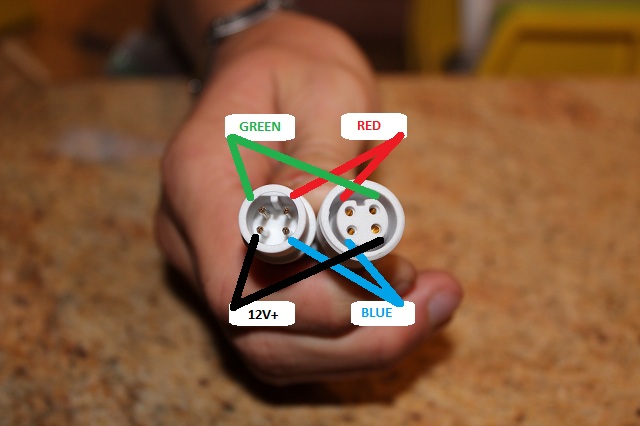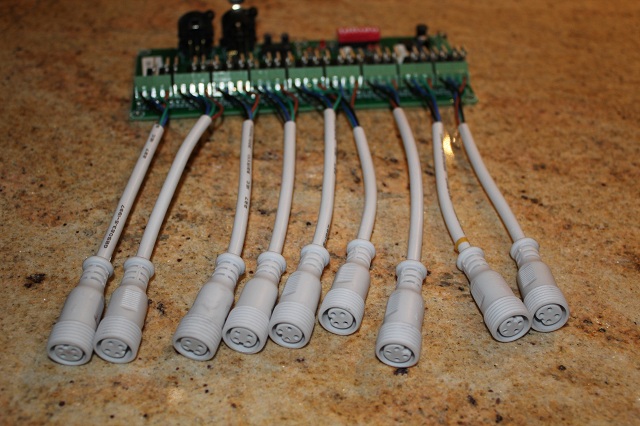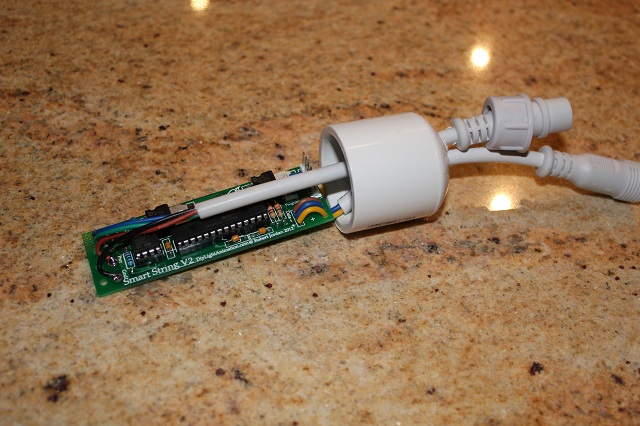Difference between revisions of "4 Conductor"
Steve Gase (Talk | contribs) (→Connector Wiring: 4-Conductor) |
Steve Gase (Talk | contribs) (→Connector Wiring: 4-Conductor) |
||
| Line 32: | Line 32: | ||
[[File:Powered-pixelnet.JPG|border|4-core connector used for pixelnet with power]] | [[File:Powered-pixelnet.JPG|border|4-core connector used for pixelnet with power]] | ||
| + | |||
| + | '''Waterproof SSC design using 3-core and 4-core connectors:''' | ||
| + | Based on negative experiences with water and the SSC / RJ-45 pigtail design, an alteration has been suggested to use 4-core waterproof connectors in place of the RJ-45 pigtail. The incoming cat5 cable must be altered to use a female 4-core connector in place of the normal cat5 jack. The SSC uses a male 4-core connector to receive the pixelnet with power from the smart string hub. The SSC then uses a female 3-core connector to send the smart string data and power to the string. | ||
| + | |||
| + | [[File:Waterproof-ssc.JPG|border|using 4-core connector for input, and 3-core connector for output]] | ||
Revision as of 00:54, 25 July 2013
Contents
Connector Wiring: 4-Conductor
The purpose of this page is to share common wiring schemes for 4-conductor systems. As additional systems are added, please include them in a form in which others can benefit.
Information on 3-Conductor (3-core) wiring schemes can be found at 3_Conductor
4-Core Water-proof connectors
Water-proof connectors are available from Ray Wu, but they can also be purchased from US-based resellers (ask around for names).
4-Core Waterproof connectors used with Dumb strings (RGB)
Dumb string controllers (MR16, DSC, and various 3rd party controllers) generate power that is passed to LEDs with inline-resistance. A 3-channel controller will pass a common 12V+ line to a string of LEDs, and ALSO pass ground line to a series of Red LEDs, a separate ground line to series of Green LEDs, and a final ground line to a series of Blue LEDs.
Using the current 4-core pigtail's wire colors as a starting point for a proposed wiring scheme, the scheme uses black for 12V+, red(brown?) wire for Red lights, green wire for Green lights, and blue wire for Blue lights.
The controller should use female connectors to prevent the exposed pins from accidental shorting. The dumb string of lights should use a male connector to receive the power from the controller.
The following picture shows 4-core female connectors attached to a 27-channel controller -- creating (9) 3-channel RGB dumb string connections.
4-Core Waterproof connectors used with Powered Pixelnet
4-conductor connectors can be used to receive pixelnet data AND power from the smart string hub. Smart string hubs can have up to (16) RJ-45 jacks. Each jack has identical data and power which is supplied to 1-16 attached SSCs. Pins 1 and 2 carry pixelnet data (Pixelnet+ and Pixelnet- respectively. Pins 3-5 carry 12V+ and Pins 6-8 carry GROUND.
By replacing a Cat5 plug on one end of a cat5 cable with a 4-core connector, the end of the cable -- normally exposed to cold and wet climates can be protected from the elements using the waterproof connector.
The SSC must be altered to use a 4-core male connector, while the cat5 'adapter' uses a female connector -- to avoid potential shorting from exposed pins.
The picture below shows the 4 lines passed into the SSC through the 4-core connector:
Waterproof SSC design using 3-core and 4-core connectors: Based on negative experiences with water and the SSC / RJ-45 pigtail design, an alteration has been suggested to use 4-core waterproof connectors in place of the RJ-45 pigtail. The incoming cat5 cable must be altered to use a female 4-core connector in place of the normal cat5 jack. The SSC uses a male 4-core connector to receive the pixelnet with power from the smart string hub. The SSC then uses a female 3-core connector to send the smart string data and power to the string.


